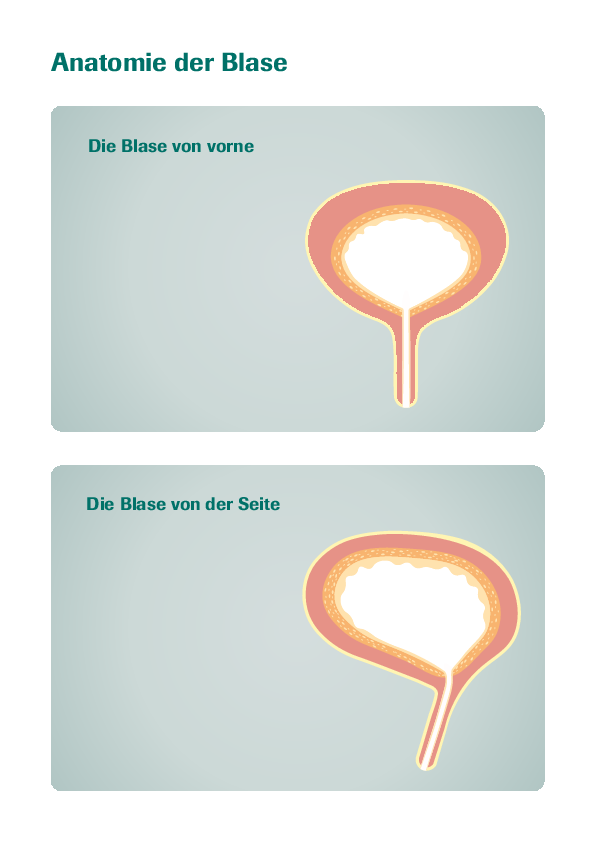Symptoms
Symptoms and progression of bladder cancer at a glance
Malignant tumours originating in the bladder are called bladder carcinomas or bladder cancer. In Germany, around 30,000 people are diagnosed with such bladder tumours every year.1Men are affected about 3 times more frequently than women.2 The average age of onset of bladder cancer is 75 for men and 77 for women.2
Possible bladder cancer symptoms
Often, bladder carcinoma does not show any symptoms in the early stages. If symptoms do occur, they tend to be unspecific. The following is possible:
- increased urge to urinate, with only little urine being released
- difficult urination or only dribbling of urine
- reddish or brown coloured urine due to blood admixtures (in 80 percent of those affected)2
If a tumour in the bladder is already at an advanced stage, pain may also occur in the lower abdomen and kidney area (at the side of the torso).
Symptoms of bladder cancer in women and men
Although it affects men significantly more often, there are generally no differences in the symptoms of bladder cancer in women and men.
Important: Although the above symptoms may indicate bladder cancer, there may be other causes that are completely harmless - for example a bladder infection. In any case, prolonged, even supposedly mild complaints should be examined by a doctor. This is especially true when pain is involved. If a bladder tumour is detected early, the chances of recovery are generally good.
Progression: different types and stages of bladder carcinoma
The decisive factor for the classification of bladder tumours is whether the cancer has already grown into the bladder wall:3
- Non-muscle-invasive bladder carcinoma is present if the tumour is limited to the bladder mucosa. This type affects around 60 to 70 percent of bladder cancer patients.
- However, in muscle-invasive bladder cancer, the tumour has already spread to the bladder wall and its muscle layer. This is the case in around 30 to 40 percent of bladder cancers.
It is also possible for an initially non-muscle-invasive bladder tumour to progress during the course of the disease - despite treatment - and spread to the bladder wall. It is not possible to say exactly how often this happens.
Difference between non-muscle-invasive and muscle-invasive bladder cancer
![[Translate to English:] Infografik zeigt den Unterschied von nicht muskelinvasivem und nicht-muskelinvasivem Blasenkrebs.](/fileadmin/apogepha/therapiegebiete/Blasenkrebs_Grafik_Blasenkrebs_Beschriftungen.png)
Bladder carcinoma is divided into different tumour stages for better classification.
Tumour stages in non-muscle-invasive bladder cancer:3
- Ta: wart-shaped tumours that are limited to the bladder mucosa
- Tis: the tumour spreads over a large area of the mucous membrane
- T1: the tumour has not yet reached the muscle layer of the bladder wall, but has already penetrated the mucous membrane
Tumour stages in muscle-invasive bladder cancer:3
- T2: the cancer has grown into the bladder wall and its muscle layer
- T3: the tumour has advanced into the adjacent fatty tissue
- T4: bladder cancer has spread to nearby organs, for example to the uterus in women or the prostate in men
In order to tailor bladder cancer treatment, it is important to classify the tumour into the appropriate stage.
Trigger
Causes and risk factors of bladder carcinoma
Cancer develops in the cells of the body. Healthy cells grow, divide and multiply in order to maintain the health and functionality of the body. However, cells can get out of control, leading to uncontrolled cell division.
These excess cells form a tumour, which can be benign or malignant. In the case of bladder cancer, such a malignant tumour originates from the bladder.
Can a tumour in the bladder also be benign?
In general, tissue proliferations without pathological character, i.e., benign tumours, are possible in the bladder. However, they are very rare. The development of malignant bladder carcinomas is much more common.
The exact cause of bladder cancer is unclear. However, there are a number of factors that increase the risk of bladder tumours. These include:
- Smoking, even passive smoking (as the main risk factor)
- Contact with certain chemical substances, for example aromatic amines (may be present in colourants or packaging material)
- Medication such as certain chemotherapeutics or radiotherapy in the pelvic area for treating cancer
- Damage to the bladder mucosa, for example due to chronic bladder infection or long-term use of a urinary catheter
Bladder cancer as an occupational disease?
For people who work with chemical substances and develop a bladder tumour through contact with these substances, it may be recognised as an occupational disease. This may include work in the chemical and pharmaceutical industries, the painting trade, the textile industry or leather processing.
Important: of course, contact with potentially hazardous chemicals should be minimised from the outset by taking appropriate health and safety measures (such as wearing protective clothing).
Diagnosis
Diagnosis of bladder cancer
The diagnosis usually starts with a detailed discussion called the anamnesis. The patient describes their symptoms and the doctor asks them about pre-existing conditions and any risk factors (for example, whether they smoke). A physical examination, in which the doctor palpates the lower abdomen and kidney area, for example, can also provide initial indications.
If bladder carcinoma is suspected, further tests are carried out. The following is possible:
This involves checking for traces of blood in the urine and any abnormalities in the blood count. Urinary cytology also analyses whether there are tumour cells in the urine.
An ultrasound of the lower abdominal region, the kidneys and the bladder is performed to detect any changes in the internal organs. Abnormalities indirectly indicate a tumour.
If blood is found in the urine, a urography of the kidneys, ureters and bladder can be performed to get an overview of the entire urinary tract.
Cystoscopy is used to examine the mucous membrane of the bladder. Here, the doctor inserts a thin tube (endoscope) through the urethra into the bladder. The tube is fitted with a camera and a light source. This enables the doctor to identify the size, extent and location of one or more existing tumours. A cystoscopy is usually needed to confirm the diagnosis of bladder cancer and to plan appropriate treatment. It is usually a low-complication and largely painless examination.
Tissue samples are taken from the bladder for histological examination under a microscope. The sample can be taken directly during a cystoscopy. This allows bladder carcinoma to be ruled out or diagnosed beyond doubt.
If it is an invasive bladder tumour that has already penetrated the bladder wall and its muscle layer, further diagnostic procedures - such as Computed Tomography (CT), Magnetic Resonance Imaging (MRI) and skeletal scintigraphy - may be used to determine how far the tumour has spread into the surrounding tissue and possibly other organs.
Which blood values increase in bladder cancer?
Blood values can provide information about the health and function of liver and kidneys. Elevated levels of GOT, GPT or creatinine may indicate that the bladder cancer has already spread. There are no specific tumour markers (substances that indicate a tumour) for bladder cancer.
Important: it may take several days or even a few weeks for all the tests to be done and for a final diagnosis to be made, or for a suspected bladder carcinoma to be ruled out completely. However, the prescribed procedures are important; the more accurately the tumour is identified, the more targeted the treatment of bladder cancer can be.
Treatment
Treatment of bladder cancer
If a bladder carcinoma is detected and treated in time, there is a good chance of complete recovery. The respective treatment and its success are directly related to the classification of the tumour.
In the treatment of bladder cancer, a basic distinction is made between non-muscle-invasive and muscle-invasive bladder tumours, as the procedures for treating each type of bladder cancer are very different.
Good to know:
Before starting treatment, your doctor will inform you in detail about all treatment options, prospects of success and possible side effects. You will also be given information about what you need to consider before and after bladder cancer treatment depending on the treatment you choose.
Treatment of non-invasive bladder carcinoma
If the bladder tumour has not grown into the muscle layer of the bladder wall and is still small, doctors can often remove it completely.
The procedure of transurethral resection of the bladder (TUR-B) is used for this. The patient is anaesthetised for this procedure. The doctor inserts an investigation instrument into the urethra which has an electrified wire loop at one end. This can then be used to remove the bladder tumour or other suspicious tissue. The procedure itself takes only about 20 to 60 minutes and the patient usually stays in hospital for one or a few days.4
If the tumour cannot be completely removed or if there is a high risk of recurrence, another procedure may be needed to remove more bladder tissue (second resection). A second resection, if needed, is usually carried out 2 to 6 weeks after TUR-B.4
Did you already know?
Complete removal of the bladder (radical cystectomy) is not usually necessary for non-invasive tumours. There may be special cases where the tumour is growing very aggressively and the risk of recurrence is therefore high.
After TUR-B, a so-called instillation therapy is often carried out as part of bladdercancer treatment to reduce the risk of recurrence. Medication is introduced via a catheter for flushing the bladder.
The exact active ingredient that patients receive, when instillation therapy starts and how long it lasts varies from person to person and depends on the risk of recurrence for the patient. Possible drugs include cytostatic drugs used in chemotherapy or Bacillus Calmette-Guérin (BCG), special bacteria that boost the body's own immune defence.
Treatment of invasive bladder carcinoma
Treatment options are available even if the bladder carcinoma has already spread to the bladder wall and its muscle layer:
If the bladder tumour has not yet spread to the surrounding tissue - for example to the abdominal wall or pelvis - doctors try to remove the tumour completely. The entire bladder is usually removed for this. In this case, an artificial urinary diversion and a type of "bladder substitute" (neobladder) are created during the procedure itself.
In addition, immunotherapy or chemotherapy is often used to target any remaining tumour cells, thus increasing the chances of a successful bladder cancer treatment. However, it may also be possible to keep the bladder and just remove the tumour, in combination with chemotherapy and radiotherapy.
If bladder carcinoma has already spread to the surrounding tissue and possibly other organs (metastasis), there is usually no cure. The focus is then on using different drugs to prolong life as much as possible, alleviate symptoms and thus improve or maintain the patient’s quality of life.
Cytostatic drugs for chemotherapy or immune checkpoint inhibitors can be used as immunotherapy.
What is the prognosis for bladder cancer?
The decisive factor for the prognosis of bladder cancer, and therefore for the chances of recovery, is mainly the stage of the tumour - i.e., whether and how far the cancer has progressed.
If the bladder carcinoma is only on the surface of the bladder mucosa, there is usually a good chance of recovery. However, the bigger and faster the tumour grows and the further it spreads (into the bladder wall and beyond), the less favourable the situation is. In addition, the prognosis for women with muscle-invasive bladder cancer is generally worse than for men. In any case, those affected should seek medical advice about their individual prognosis.
Prevention
What can you do for bladder cancer prevention
Even if the exact causes are still unclear, there are things you can actively do to reduce your risk of bladder carcinoma:
- Give up cigarettes or try to quit smoking.
- Eat a balanced and healthy diet to reduce the risk of cancer in general.
- Regular daily exercise and sport are also good for cancer prevention.
There is currently no recommended detection test for bladder cancer for the general population. This makes it all the more important to take any symptoms - such as blood in your urine or pain in your abdomen - seriously and get them checked by a doctor as soon as possible.
Specialist groups
Bladder carcinoma: information for specialist groups
Every year, around 7,540 women and 23,270 men are newly diagnosed with bladder carcinoma in Germany.1 This makes it the fourth most common type of cancer in men and the eighth most common in women.5
Non-invasive bladder tumours can be treated easily if detected early, but there is an increased risk of progression and recurrence of the disease if not treated adjuvantly after a TUR-B. Therefore, they are of particular clinical relevance.
To access detailed product information on the treatment of non-invasive bladder carcinoma via the specialist group login, click here:
Downloads
Bladder cancer - services and downloads
Download free information and service material on bladder cancer quickly and easily from here:
FAQ
Frequently asked questions and answers about bladder cancer
A bladder tumour often causes no symptoms at first. However, if symptoms of bladder cancer occur, they tend to be unspecific. Possible symptoms include trouble passing urine or a reddish/brownish colour to the urine.
Bladder cancer is often painless at first. Pain occurs especially when bladder cancer is already advanced. In this case, a doctor should definitely be consulted.
Bladder cancer is a serious, potentially fatal type of cancer. The survival rate depends heavily on the stage of the tumour. In principle, however, treatment options are still available for advanced bladder cancer.
This depends mainly on how advanced the bladder tumour is. If bladder cancer is detected early, the chances of recovery are generally good.
Inform your doctor immediately if you notice any new or changed symptoms or side effects of the treatment. Consult your doctor if you are taking additional medication. It is also important to attend all recommended check-ups and treatment appointments.
If you smoke, make sure you stop. Living as healthy a life as possible, including a balanced diet and plenty of exercise, is also generally beneficial for the course of the disease. This also benefits the immune system.
Sources
- 1 "RKI - Cancer in Germany". Robert Koch Institute, https://www.krebsdaten.de/Krebs/DE/Content/Publikationen/Krebs_in_Deutschland/kid_2023/kid_2023_c67_harnblase.pdf?__blob=publicationFile. Accessed on 01 October 2024.
- 2 "Bladder cancer (bladder carcinoma)". German Cancer Aid Foundation, https://www.krebshilfe.de/informieren/ueber-krebs/krebsarten/blasenkrebs-harnblasenkarzinom/. Accessed on 18 July 2024.
- 3 Kraywinkel, Klaus, et. al. “Epidemiologie des Harnblasenkarzinoms in Deutschland” (Epidemiology of urinary bladder carcinoma in Germany). Der Onkologe: Organ of the Deutsche Krebsgesellschaft e.V, Vol. 24, No. 1, 2018, pp. 6-13, https://doi.org/10.1007/s00761-017-0325-4.
- 4 “Therapie bei nicht-muskelinvasivem Blasenkrebs” (Treatment of non-muscle-invasive bladder cancer). Cancer Information Service, German Cancer Research Centre, https://www.krebsinformationsdienst.de/blasenkrebs/nicht-muskelinvasiv-behandlung. Accessed on 18 July 2024.
- 5 Krebshäufigkeit – die aktuellen Zahlen” (Cancer incidence - the latest figures). Onko Internetportal, German Cancer Society, https://www.krebsgesellschaft.de/onko-internetportal/basis-informationen-krebs/allgemeine-informationen/krebshaeufigkeit-die-aktuellen-daten.html. Accessed on 18 July 2024.


![[Translate to English:] Älteres Paar tanzend in der Küche: Zunehmendes Alter ist ein Risikofaktor für Blasenkrebs.](/fileadmin/_processed_/c/8/csm_AdobeStock_355906179_599a569b5c.jpg)


![[Translate to English:] [Translate to English:] Person zeigt mit Hand auf virtuelles Modell einer Blase.](/fileadmin/apogepha/mood-fotos-stock/AdobeStock_523304375.jpg)
